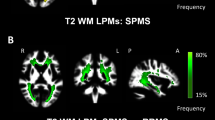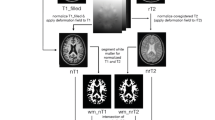Abstract
Purpose
The aim of this study was to assess differences in the presence, size, number and site of dilated cerebral Virchow–Robin spaces (VRSd) between patients with multiple sclerosis (MS) in the inactive phase and healthy controls, and between MS patients with disabling (MSd) or nondisabling (MSnd) disease.
Materials and methods
The study was performed by retrospectively analysing the 3 T magnetic resonance studies of 40 MS patients and 30 healthy subjects (matched for age, education and gender). The data were analysed with MIPAV (Medical Image Processing, Analysis and Visualisation) software to assess for VRSd and with FSL SIENA-X to measure global cerebral atrophy (GCA) expressed as brain parenchyma fraction.
Results
The MS patients had significantly higher VRSd number (p < 0.011), area (p < 0.0073) and volume (p < 0.0071) than controls, with a marked increase for atypical sites (p < 0.0069) without significant intragroup differences between the disease forms (MSd vs MSnd). The number and size of VRSd did not correlate with GCA.
Conclusions
Our results confirm previous reports regarding the increase in VRSd in nonactive phases of MS and support the immunological role of the VRS within the central nervous system. The lack of correlation between VRSd and the degree of GCA and their prevailing localisation in atypical sites in MS patients make VRSd a potential marker of inflammatory-demyelinating disease.



Similar content being viewed by others
References
Tsutsumi S, Masanori I, Yasumoto Y et al (2011) The Virchow–Robin space: delineation by magnetic resonance imaging with considerations on anatomofunctional implications. Child Nerv Syst 27:2057–2066
Wuerfel J, Haertle M, Waiczies H et al (2008) Perivascular spaces—MRI marker of inflammatory activity in the brain? Brain 131:2332–2340
Wang G (2009) Perivascular space and neurological disorders. Neurosci Bull 25:33–37
Fanous R, Midia M (2007) Perivascular spaces: normal and giant. Can J Neurol Sci 34:5–10
Inglese M, Bomsztyk E, Gonen O et al (2005) Dilated perivascular spaces: hallmarks of mild traumatic brain injury. AJNR 26:719–724
Kwee RM, Kwee TC (2007) Virchow–Robin spaces at MR imaging. Radiographics 27:1071–1086
Di Costanzo A, Di Salle F, Santoro L et al (2001) Dilated Virchow–Robin spaces in myotonic dystrophy: frequency, extent and significance. Eur Neurol 46:131–139
Achiron A, Faibel M (2002) Sandlike appearance of Virchow–Robin spaces in early multiple sclerosis: a novel neuroradiologic marker. AJNR 23:376–380
Mohan S, Verm A, Sitoh Y-Y, Kumar S (2009) Virchow–Robin spaces in health and disease. Neuroradiol J 22:518–524
Yc Zhu, Dufouil C, Mazoyer B (2011) Frequency and location of dilated Virchow–Robin spaces in elderly people: a population based 3D MR imaging study. AJNR 32:709–713
Barkhof F (2004) Virchow–Robin spaces: do they matter? The clinical significance of widened Virchow–Robin spaces. J Neurol Neurosurg Psychiatry 75:1516
Groeschel S, Chong Wk, Surtees R, Hanefeld F (2006) Virchow–Robin spaces on magnetic resonance images: normative data, their dilatation, and a review of the literature. Neuroradiology 48:745–754
Etemadifar M, Hekmatnia A, Tayari N et al (2011) Features of Virchow–Robin spaces in newly diagnosed multiple sclerosis patients. Eur J Radiol 80:e104–e108
Algin O, Conforti R, Saturnino PP et al (2012) Giant dilatations of Virchow–Robin spaces in the midbrain: MRI aspects and review of the literature. Neuroradiol J 25:415–422
Tortora F, Cirillo M, Belfiore MP et al (2012) Spontaneous regression of dilated Virchow–Robin spaces. A case report. Neuroradiol J 25:40–44
Sturiale CL, Albanese A, Lofrese G et al (2011) Pathological enlargement of midbrain Virchow–Robin spaces: a rare cause of obstructive hydrocephalus. Br J Neurosurg 25:130–131
Vos CMP, Geurts JJG, Montagne L et al (2005) Blood–brain barrier alterations in both focal and diffuse abnormalities on postmortem MRI in multiple sclerosis. Neurobiol Dis 20:953–960
Doubal FN, Maclullich AMJ, Ferguson KJ et al (2010) Enlarged perivascular spaces on MRI are a feature of cerebral small vessel disease. Stroke 41:450–454
De Vita E, Thomas DL, Roberts S (2003) High resolution MRI of the brain at 4.7 Tesla using fast spin echo imaging. Br J Radiol 76:631–637
Tsitouridis I, Papaioannou S, Arvaniti M et al (2008) Enhancement of Robin–Virchow spaces: MRI evaluation. Neuroradiol J 21:490–499
Conflict of interest
Renata Conforti, Mario Cirillo, Pietro Paolo Saturnino, Antonio Gallo, Rosaria Sacco, Alberto Negro, Antonella Paccone, Giuseppina Caiazzo, Alvino Bisecco, Simona Bonavita, Sossio Cirillo declare that they have no conflict of interest related with the publication of this article.
Author information
Authors and Affiliations
Corresponding author
Rights and permissions
About this article
Cite this article
Conforti, R., Cirillo, M., Saturnino, P.P. et al. Dilated Virchow–Robin spaces and multiple sclerosis: 3 T magnetic resonance study. Radiol med 119, 408–414 (2014). https://doi.org/10.1007/s11547-013-0357-9
Received:
Accepted:
Published:
Issue Date:
DOI: https://doi.org/10.1007/s11547-013-0357-9




